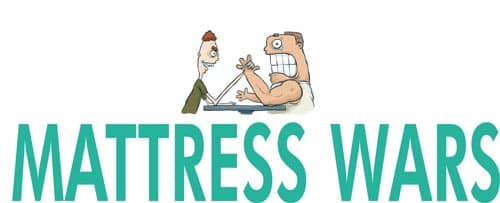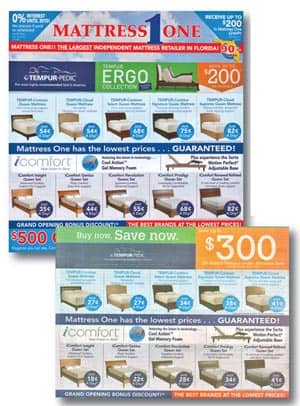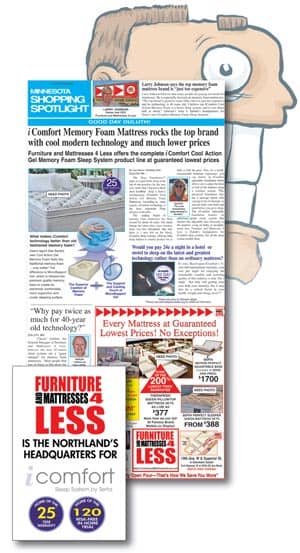
The young saleslady smiled confidently. “Are you interested in a memory foam mattress?” she asked. I explained that I wasn’t going to buy anything, that I was researching an article for Furniture World. She was a bit disappointed, but with no other prospective customers in sight, she seemed willing to continue to visit with me.
I was in a medium size northern Minnesota city, and the 80,000 sq. ft. store was one of the most beautiful I have ever seen. The saleslady explained to me that Tempur-Pedic customers had always come to the store pre-sold on the product. She said people already understand the many benefits that brand advertises. They expect unique pressure-relieving comfort, and an ability to conform to each person's body. They know about the durability and quality of the product, and motion isolation properties. So, even though it is an expensive sleep system, selling a Tempur-Pedic product, for her, is a relative breeze.
Then recently, Serta iComfort came along with a new story. On their website they used a soft-sell but very effective strategy. iComfort experts told customers that traditional memory foam technology hasn’t changed much since it was invented more than four decades ago. And while it has been the perfect bed for many people, others had issues with it. Some felt sleeping on a memory foam mattress was too hot. Others felt they sink in too deeply and this made it hard to adjust sleep positions. Then iComfort asked the killer question: Isn’t it about time that someone reinvented memory foam? This sounded more and more like a good idea, especially since Serta’s iComfort was priced at about half the price of Tempur-Pedic.
iComfort branded itself as “the world’s first memory foam infused with the support and cooling touch of Micro Support gel.” The brand declared that it was a revolutionary new memory foam Sleep System featuring Cool Action Gel Memory Foam promising to deliver superior pressure relief and more targeted support while sleeping cooler, plus, antimicrobial and dust mite resistance. iComfort offered a longer warranty and a longer in home free trial. So, at a lower price, what was not to like?
The Missing Link In Mattress Sales
The missing link in retail mattress sales is the disconnect between the competence and marketing expertise of the mattress manufacturers and the weakness of the retailers.
Let’s examine the Tempur-Pedic strategy. How did Temper-Pedic achieve the ability to pre-sell customers on their products to an unprecedented degree? After a decade of relative obscurity, the company became an overnight success when they applied the principles of evidence-based advertising. First, they developed a compelling story and a U.S.P. [Unique Selling Proposition] for their website and print media. “In the early 1970s, NASA developed a pressure-absorbing material to help cushion and support astronauts during lift-off. The material was temperature-sensitive and it evenly distributed body weight. NASA released this material to the public in the 1980s.
Another set of scientists … continued development on NASA’s creation. After nearly a decade and millions of research dollars, these “Swedish scientists” perfected TEMPUR material for use in mattresses.”
 |
Mattress One, the largest mattress retailer in Florida, now features equal space in their weekly flyers for Tempur-Pedic and iComfort. These two brands usually are collectively granted half the advertising space in Mattress One flyers and ROP ads. The marketing people for Mattress One have elected to present five models of each brand. They are priced in an unusual way, by the cost per day for owning a Tempur-Pedic or an iComfort sleep system.
|
This “Tempur material” is their key product feature. But so far it is a “so-what?” story. The marketing brains at Tempur-Pedic then did something that other home furnishings manufacturers and retailers continue to fail to do. They took the next step and elevated their story into something compelling for potential customers. They explained the benefits that their product provides and answered the prospect’s ever-prevailing question: “So what? What’s in it for me?”
Every savvy salesperson knows that you should never describe a product feature without explaining the benefits it provides. Yet look-alike retail furniture ads generally use price-item features, label headlines, and are almost bereft of benefits. Moreover, even the Big Boxes fail to establish and localize their brand. Tempur-Pedic experts know this, so they compensate for poor retail advertising by pre-selling prospects with their own benefit-rich presentations. Rather than provide CO-OP, Tempur-Pedic sells their unique brand directly to the customer.
The other top mattress brands do offer CO-OP dollars to retailers and offer attractive preprinted flyers. However, manufacturer flyers sell their own brand, not the retailer’s identity and distinct advantages. There is little dealer identification other than a logo. So, when a dealer runs a preprinted flyer from Sealy, Simmons, or Serta, he sells their products for every other dealer in his area as well as for himself. The ultimate selling proposition would do both. It would sell prospects on the manufacturer’s products, and also present compelling reasons why they should buy from this particular dealer.
Tempur-Pedic promises continued product innovation in their web presentations. But Serta’s iComfort politely suggests that Tempur-Pedic hasn’t changed its product much in forty years. They state that Tempur-Pedic has a great product but: “Isn’t it about time that someone reinvented memory foam?” The strategy seems to be working.
Something Odd Is Going On IN Retail Furniture & Bedding Stores
Although many retailers have brushed off the idea that a Serta product could threaten Tempur-Pedic’s market dominance, smart retailers do not. If you carry both Tempur-Pedic and iComfort it will be difficult to exploit the changing market conditions. For example, Mattress One, the largest mattress retailer in Florida, now features equal space in their weekly flyers for Tempur-Pedic and iComfort. These two brands usually are collectively granted half the advertising space in Mattress One flyers. The marketing people for Mattress One have elected to present five models of each brand. They are priced in an unusual way, by the cost per day for owning a Tempur-Pedic or an iComfort sleep system. In very small print they explain this cost per day in this way: “Daily cost of ownership is based on a 10 year Full Replacement Warranty of Mattress.” For example, the starting price point for a Tempur-Pedic is 54 cents a day based upon their 10 year full replacement warranty. iComfort starting price point is listed as 35 cents a day based on the same 10-year disclaimer.
But hold on! iComfort actually has a fifteen year full replacement warranty. Based on this, the iComfort price point would be 29 cents a day, not 35, making it almost half the price of Tempur-Pedic. Perhaps this was simply an oversight by Mattress One, but it went on for months. Then Tempur-Pedic introduced new lower priced models, and the Mattress One changed their ads. They decided to base their per-night cost for both brands on Tempur-Pedic’s “20 year warranty life of the mattress” [this is a limited prorated warranty] instead of Tempur-Pedic’s ten year full replacement warranty. Their new presentation does mitigate to some degree the price differential, and perhaps mollifies the price-comparison concerns of Tempur-Pedic.
But hold on again! iComfort has a twenty-five year life of the mattress limited warranty. Using a twenty-year warranty obviously skews the price comparisons in favor of Tempur-Pedic. Why Mattress One does this is anyone’s guess.
In another retail development, the Wall Street Journal recently reported that an 800 store chain, Mattress Firm, reports that as much as 40% of their sales now come from memory-foam and other non-innerspring mattresses. I know that for some retailers, their memory foam sales actually surpass their innerspring sales.
 |
Some retailers are using the iComfort advertising strategy to successfully establish themselves as the source for memory foam sleep systems. One Serta dealer in Duluth is using print media, radio and in-store signs that claim iComfort sleep systems superiority over the “40-year old
technology.”
|
And The Winner Is?
The jury is still out, but it has been said that the only thing that simultaneously creates destruction and growth is change. And change is inevitable. If you are a manufacturer or a retailer, how can you benefit from these changing mattress retailing trends? By embracing them.
If you are a manufacturer, you could become the winner if you are willing to step out of your comfort zone and consider the situation of the mattress retailers. They need help. Few of them know how to create a unique identity and stand out among the crowd of other retailers. Your marketing experts could help them. Instead of focusing exclusively on your own product, give them some help in building their own brand.
You both will do more business. I have written here that the missing link in retail mattress sales is the disconnect between the competence and marketing expertise of the mattress manufacturers and the weakness of the retailers. The first manufacturer who understands this–and helps the retailer develop a unique identity and stand out from the crowd–will be the winner.
If you are an independent retailer, there may be an opportunity here to capture a larger market share of memory foam business. Here is one way to do it. If you do not carry Tempur-Pedic, you are probably not getting your fair share of memory foam business. Consider your options. Many leading brands have also have their own version of an advanced memory foam product. (Including a new, lower priced Tempur-Pedic). In the exhibits of this article you will see how some retailers are using the iComfort advertising strategy to establish themselves as the source for memory foam sleep systems in their trading areas. One Serta dealer I know is using print media, TV, radio and in-store signs that feature iComfort sleep systems over the “40-year old technology.” A Restonic dealer is doing the same thing with Restonic TempaGel Healthrest Memory Foam sleep systems, one of the huge number of the “new, advanced,” lower cost memory foam products on the market.)
It is likely that Tempur-Pedic, with its sophisticated evidence-based marketing methods will continue to dominate memory foam sleep systems for the foreseeable future. Even so, you could double or triple your own share of this market with an aggressive marketing strategy.
A Key factor in your success will be your ability to load your messages with benefits. Remember the simple, basic principles toward overcoming the “So what?” reaction to your advertising messages. Product features support benefits. People do not need or want a memory foam mattress. They want better sleep. When they sleep better, they will be happier and healthier. The ever prevailing question of the consumer is always, “What’s in it for me?” This will be followed by: “Why should I buy from you?”
If you are an independent retailer, you can be the biggest winner in the mattress wars if you can answer these questions with clarity and confidence.
Larry Mullins is a contributing editor for Furniture World and has 30+ years of experience on the front lines of furniture marketing. Larry’s mainstream executive experience, his creative work with promotion specialists, and mastery of advertising principles have established him as one of the foremost experts in furniture marketing. His affordable High-Impact programs produce legendary results for everything from cash raising events to profitable exit strategies. His newest books, THE METAVALUES BREAKTHROUGH and IMMATURE PEOPLE WITH POWER… How to Handle Them have recently been released by Morgan James Publishing. Joe Girard, “The World’s Greatest Salesman” said of this book: “If I had read Larry Mullins’ book when I started out, I would have reached the top much sooner than I did.” Larry is founder and CEO of UltraSales, Inc. and can be reached directly at 904.794.9212 or at Larrym@furninfo.com. See more articles by Larry at www.furninfo.com or www.ultrasales.com.